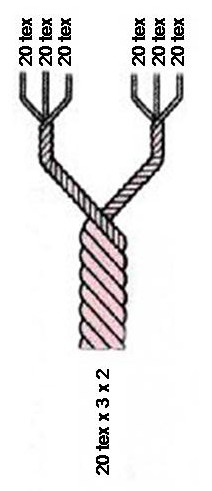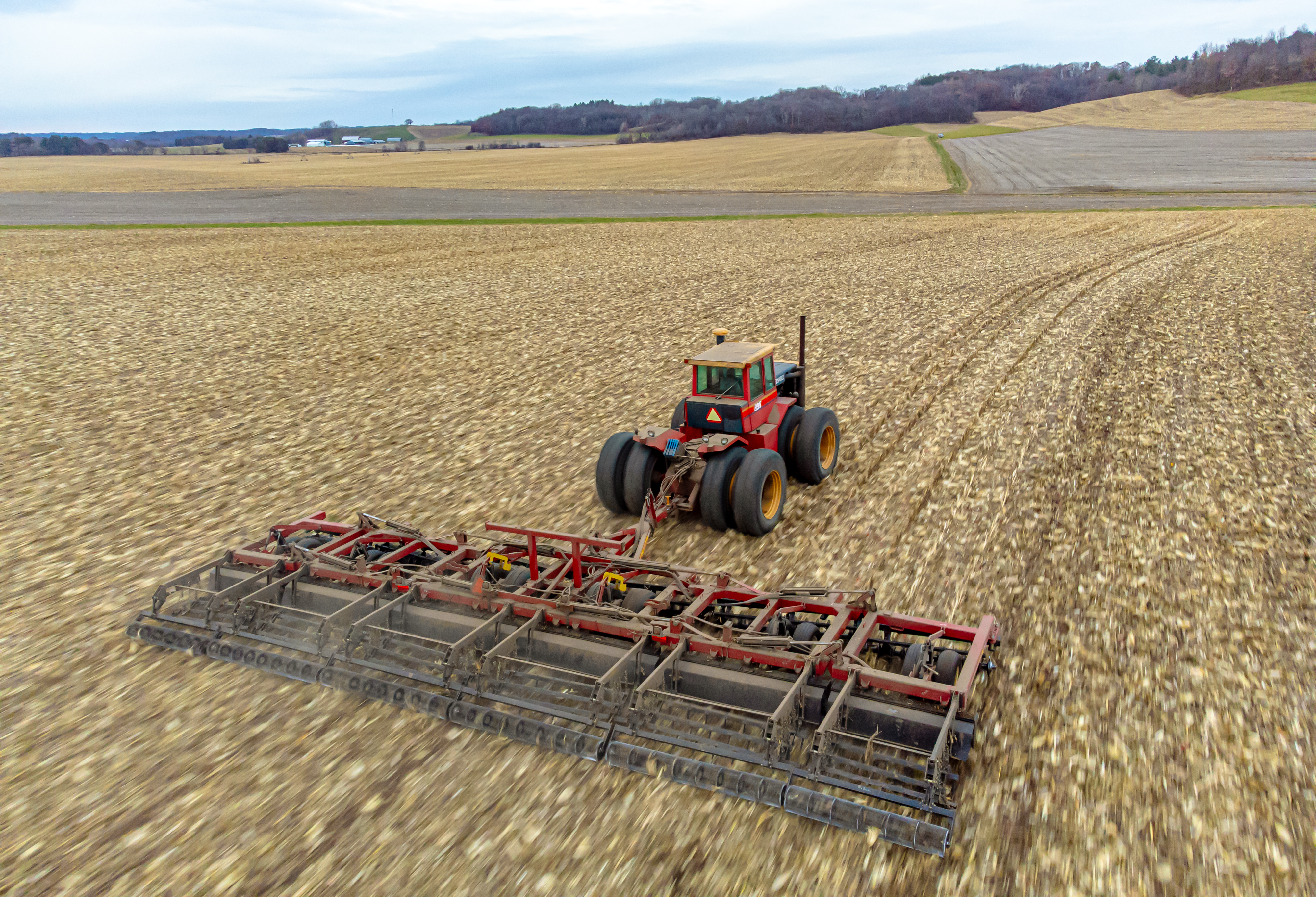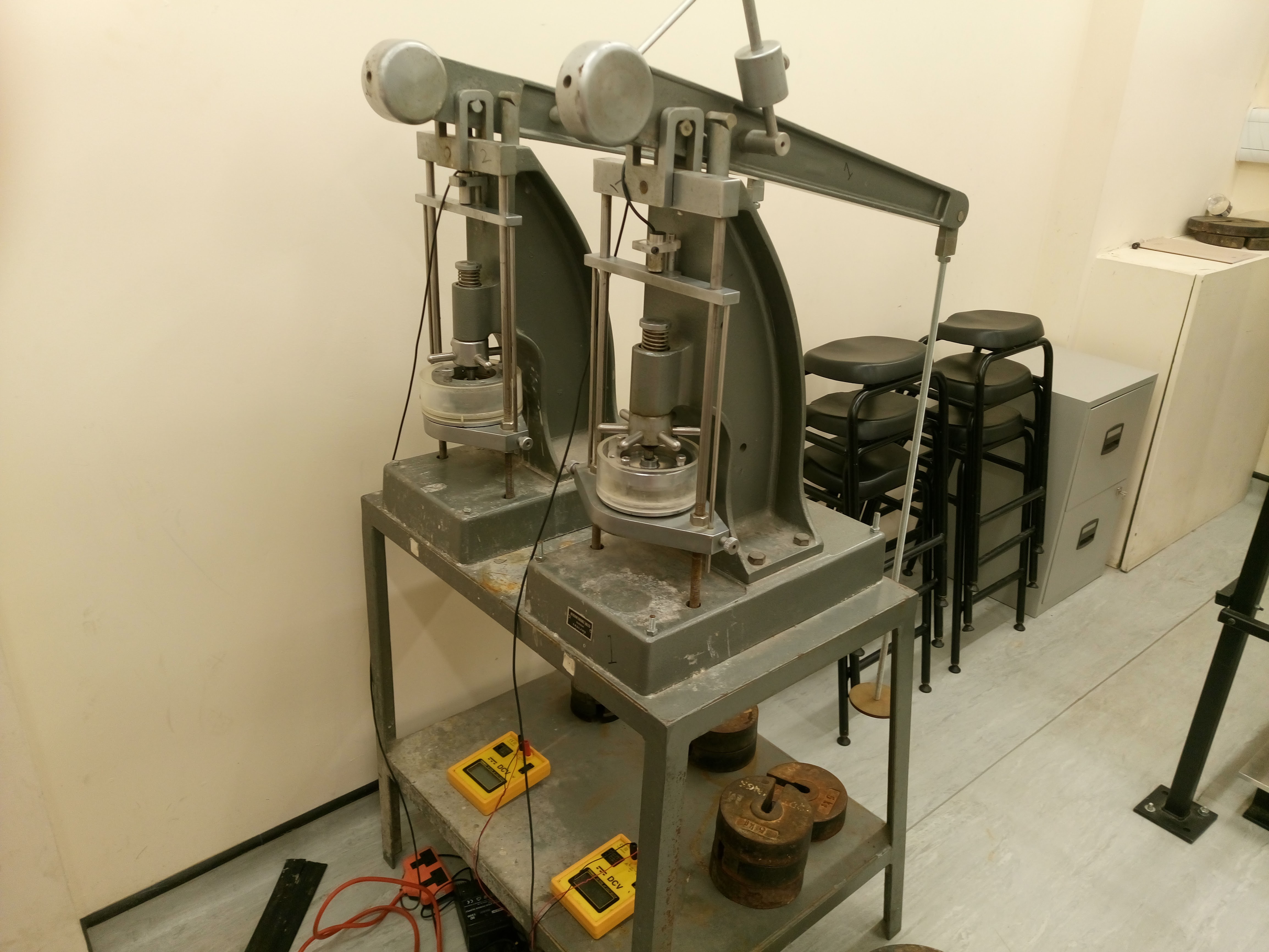|
Soil Compaction (agriculture)
Soil compaction, also known as soil structure degradation, is the increase of bulk density or decrease in porosity of soil due to externally or internally applied loads. Compaction can adversely affect nearly all physical, chemical and biological properties and functions of soil. Together with soil erosion, it is regarded as the "costliest and most serious environmental problem caused by conventional agriculture." In agriculture, soil compaction is a complex problem in which soil, crops, weather and machinery interact. External pressure due to the use of heavy machinery and inappropriate soil management can lead to the compaction of subsoil, creating impermeable layers within the soil that restrict water and nutrient cycles. This process can cause on-site effects such as reduced crop growth, yield and quality as well as off-site effects such as increased surface water run-off, soil erosion, greenhouse gas emissions, eutrophication, reduced groundwater recharge and a loss of bio ... [...More Info...] [...Related Items...] OR: [Wikipedia] [Google] [Baidu] |
Soil Salinity
Soil salinity is the salt (chemistry), salt content in the soil; the process of increasing the salt content is known as salinization (also called salination in American and British English spelling differences, American English). Salts occur naturally within soils and water. Salinization can be caused by natural processes such as mineral weathering or by the gradual withdrawal of an ocean. It can also come about through artificial processes such as irrigation and Sodium_chloride#Road_salt, road salt. Natural occurrence Salt (chemistry), Salts are a natural component in soils and water. The ions responsible for salinization are: Sodium, Na+, Potassium, K+, Calcium, Ca2+, Magnesium, Mg2+ and Chlorine, Cl−. Over long periods of time, as soil minerals weathering, weather and release salts, these salts are flushed or leached out of the soil by drainage water in areas with sufficient precipitation. In addition to mineral weathering, salts are also deposited via dust and precipitatio ... [...More Info...] [...Related Items...] OR: [Wikipedia] [Google] [Baidu] |
Ethylene
Ethylene (IUPAC name: ethene) is a hydrocarbon which has the formula or . It is a colourless, flammable gas with a faint "sweet and musky" odour when pure. It is the simplest alkene (a hydrocarbon with carbon–carbon bond, carbon–carbon double bonds). Ethylene is widely used in the chemical industry, and its worldwide production (over 150 million tonnes in 2016) exceeds that of any other organic compound. Much of this production goes toward creating polyethylene, which is a widely used plastic containing polymer chains of ethylene units in various chain lengths. Production greenhouse gas emissions, emits greenhouse gases, including methane from feedstock production and carbon dioxide from any non-sustainable energy used. Ethylene is also an important natural plant hormone and is used in agriculture to induce ripening of fruits. The hydrate of ethylene is ethanol. Structure and properties This hydrocarbon has four hydrogen atoms bound to a pair of carbon atoms that are con ... [...More Info...] [...Related Items...] OR: [Wikipedia] [Google] [Baidu] |
Plant Root
In vascular plants, the roots are the organs of a plant that are modified to provide anchorage for the plant and take in water and nutrients into the plant body, which allows plants to grow taller and faster. They are most often below the surface of the soil, but roots can also be aerial or aerating, that is, growing up above the ground or especially above water. Function The major functions of roots are absorption of water, plant nutrition and anchoring of the plant body to the ground. Types of Roots (major rooting system) Plants exhibit two main root system types: ''taproot'' and ''fibrous'', with variations like adventitious, aerial, and buttress roots, each serving specific functions. Taproot System Characterized by a single, main root growing vertically downward, with smaller lateral roots branching off. Examples. Dandelions, carrots, and many dicot plants. Fibrous RootSystem Consists of a network of thin, branching roots that spread out from the base of the stem, ... [...More Info...] [...Related Items...] OR: [Wikipedia] [Google] [Baidu] |
Water Infiltration
Infiltration is the process by which water on the ground surface enters the soil. It is commonly used in both hydrology and soil sciences. The infiltration capacity is defined as the maximum rate of infiltration. It is most often measured in meters per day but can also be measured in other units of distance over time if necessary. The infiltration capacity decreases as the soil moisture content of soils surface layers increases. If the precipitation rate exceeds the infiltration rate, runoff will usually occur unless there is some physical barrier. Infiltrometers, parameters and rainfall simulators are all devices that can be used to measure infiltration rates. Infiltration is caused by multiple factors including; gravity, capillary forces, adsorption, and osmosis. Many soil characteristics can also play a role in determining the rate at which infiltration occurs. Factors that affect infiltration Precipitation Precipitation can impact infiltration in many ways. The ... [...More Info...] [...Related Items...] OR: [Wikipedia] [Google] [Baidu] |
Air Permeability
Textile fibers, threads, yarns and fabrics are measured in a multiplicity of units. * A fiber, a single filament of natural material, such as cotton, linen or wool, or artificial material such as nylon, polyester, metal or mineral fiber, or human-made cellulosic fibre like viscose, Modal, Lyocell or other rayon fiber is measured in terms of linear mass density, the weight of a given length of fiber. Various units are used to refer to the measurement of a fiber, such as: the denier and tex (linear mass density of fibers), super S (fineness of wool fiber), worsted count, woolen count, linen count (wet spun) (or Number English (Ne)), cotton count (or Number English (Ne)), Number metric (Nm) and yield (the reciprocal of denier and tex). * A yarn, a spun agglomeration of fibers used for knitting, weaving or sewing, is measured in terms of cotton count and yarn density. * Thread, usually consisting of multiple yarns plied together producing a long, thin strand used in sewing or ... [...More Info...] [...Related Items...] OR: [Wikipedia] [Google] [Baidu] |
No Tillage
No-till farming (also known as zero tillage or direct drilling) is an agricultural technique for growing crops or pasture without disturbing the soil through tillage. No-till farming decreases the amount of soil erosion tillage causes in certain soils, especially in sandy and dry soils on sloping terrain. Other possible benefits include an increase in the amount of water that infiltrates the soil, soil retention of organic matter, and nutrient cycling. These methods may increase the amount and variety of life in and on the soil. While conventional no-tillage systems use herbicides to control weeds, organic systems use a combination of strategies, such as planting cover crops as mulch to suppress weeds. There are three basic methods of no-till farming. "Sod seeding" is when crops are sown with seeding machinery into a sod produced by applying herbicides on a cover crop (killing that vegetation). "Direct seeding" is when crops are sown through the residue of previous crop. "Surfa ... [...More Info...] [...Related Items...] OR: [Wikipedia] [Google] [Baidu] |
Topsoil
Topsoil is the upper layer of soil. It has the highest concentration of organic matter and microorganisms and is where most of the Earth's biological soil activity occurs. Description Topsoil is composed of mineral particles and organic matter and usually extends to a depth of 5-10 inches (13–25 cm). Together these make a substrate capable of holding water and air which encourages biological activity. There are generally a high concentration of roots in topsoil since this is where plants obtain most of their vital nutrients. It also plays host to significant bacterial, fungal and entomological activity without which soil quality would degrade and become less suitable for plants. Bacteria and fungi can be essential in facilitating nutrient exchange with plants and in breaking down organic matter into a form that roots can absorb. Insects also play important roles in breaking down material and aerating and rotating the soil. Many species directly contribute to the he ... [...More Info...] [...Related Items...] OR: [Wikipedia] [Google] [Baidu] |
Livestock
Livestock are the Domestication, domesticated animals that are raised in an Agriculture, agricultural setting to provide labour and produce diversified products for consumption such as meat, Egg as food, eggs, milk, fur, leather, and wool. The term is sometimes used to refer solely to animals which are raised for consumption, and sometimes used to refer solely to farmed ruminants, such as cattle, sheep, and goats. The breeding, maintenance, slaughter and general subjugation of livestock called ''animal husbandry'', is a part of modern agriculture and has been practiced in many cultures since humanity's transition to farming from hunter-gatherer lifestyles. Animal husbandry practices have varied widely across cultures and periods. It continues to play a major economic and cultural role in numerous communities. Livestock farming practices have largely shifted to intensive animal farming. Intensive animal farming increases the yield of the various commercial outputs, but also nega ... [...More Info...] [...Related Items...] OR: [Wikipedia] [Google] [Baidu] |
Tillage
Tillage is the agriculture, agricultural preparation of soil by mechanical wikt:agitation#Noun, agitation of various types, such as digging, stirring, and overturning. Examples of manual labour, human-powered tilling methods using hand tools include shoveling, pickaxe, picking, mattock work, hoe (tool), hoeing, and rake (tool), raking. Examples of working animal, draft-animal-powered or mechanization, mechanized work include ploughing (overturning with moldboards or chiseling with chisel shanks), rotary tiller, rototilling, rolling with cultipackers or other roller (agricultural tool), rollers, harrow (tool), harrowing, and cultivating with cultivator shanks (teeth). Tillage that is deeper and more thorough is classified as primary, and tillage that is shallower and sometimes more selective of location is secondary. Primary tillage such as ploughing tends to produce a rough surface finish, whereas secondary tillage tends to produce a smoother surface finish, such as that required ... [...More Info...] [...Related Items...] OR: [Wikipedia] [Google] [Baidu] |
Soil Consolidation
Soil consolidation refers to the soil mechanics, mechanical process by which soil changes volume gradually in response to a change in pressure. This happens because soil is a three-phase material. The first phase consists of soil grains, and a combination of void (air) or other fluid (typically groundwater) comprise the second and third phases. When soil soil saturation, saturated with water is subjected to an increase in pressure, the high bulk modulus, volumetric stiffness of water compared to the soil matrix means that the water initially absorbs all the change in pressure without changing volume, creating excess pore water pressure. As water diffuses away from regions of high pressure due to seepage, the soil matrix gradually takes up the pressure change and shrinks in volume. The theoretical framework of consolidation is therefore closely related to the concept of effective stress, and hydraulic conductivity. The early theoretical modern models were proposed one century ago, ... [...More Info...] [...Related Items...] OR: [Wikipedia] [Google] [Baidu] |
Soil PH
Soil pH is a measure of the acidity or basicity (alkalinity) of a soil. Soil pH is a key characteristic that can be used to make informative analysis both qualitative and quantitatively regarding soil characteristics. pH is defined as the negative logarithm (base 10) of the activity of hydronium ions ( or, more precisely, ) in a solution. In soils, it is measured in a slurry of soil mixed with water (or a salt solution, such as ), and normally falls between 3 and 10, with 7 being neutral. Acid soils have a pH below 7 and alkaline soils have a pH above 7. Ultra-acidic soils (pH 9) are rare. Soil pH is considered a master variable in soils as it affects many chemical processes. It specifically affects plant nutrient availability by controlling the chemical forms of the different nutrients and influencing the chemical reactions they undergo. The optimum pH range for most plants is between 5.5 and 7.5; however, many plants have adapted to thrive at pH values ... [...More Info...] [...Related Items...] OR: [Wikipedia] [Google] [Baidu] |




